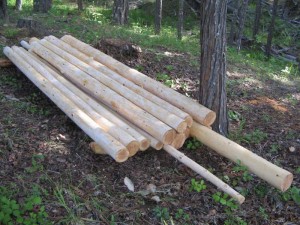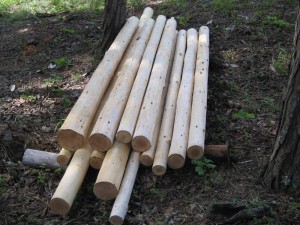
We can produce hand peeled poles of just about any size. Unlike most commercially available poles that are peeled mechanically or come from peeler cores, hand peeled poles and logs produce a more natural looking product.
Mechanical peelers produce a more uniform diameter, but also leave the surface splintery. Peeling by hand removes the bark without disturbing the natural wood surface. This creates a pole with a natural smooth surface with all the natural characteristics of the log, including the natural taper.
In young conifer stands that grow back naturally after fire or harvest, the trees commonly grow back overstocked. Conifers like Douglas fir and ponderosa pine can be very prolific. After any soil disturbance, natural reseeding will often produce a very thick stand of new trees.
As these thick trees compete with each other, these thick stands produce trees that are tall and thin with small limbs. Most of the growth of these trees go into height to compete for light. Thinning these trees by removing the slower growing ones and leaving the faster growing and better formed trees will allow the remaining trees to grow faster and produce more wood.
The trees that are harvested from these types of stands make excellent poles. They tend to be long narrow and straight with very little taper. They also have small knots and in some cases none at all because of self pruning. These trees also tend to grow more slowly and have tight rings. This produces more dense and stronger wood.
Poles can be used for pole buildings, fencing, railing, pole furniture and more. Peeled poles are usually desired most by consumers. When the bark is peeled off and the bare wood is exposed, the poles are more beautiful and will last longer if outdoors. When the bark is left on it will eventually fall off naturally if left in the weather. But until it does, it can attract insects that could burrow into the wood and also hold moisture and cause the wood to decay.
There are tools and techniques used for peeling poles. Some mechanical and some for hand peeling. One of the best ways to peel them is by hand in the spring or early summer. When the trees start to grow in the spring, the bark becomes easy to peel as the cambium layer underneath the bark starts to grow. At this time a fresh cut tree will peel right off, often in large pieces and sometimes without much need for any tools if the bark is thin enough. It is very important to do this at the right time of year because late summer through winter when the bark tightens up, this is very difficult to do. They also must be peeled when they are fresh cut. When the poles start to dry, peeling them becomes difficult.
Peeling poles this way produces a very clean smooth pole. If done carefully the surface of the wood will be 100% intact with no gouges or left over bark. It is more labor intensive when done this way vs mechanical peelers, but the end product is much more beautiful.

We are looking for 24″ od peeled pine poles which range from 37′-1″ to 31′-1″. We required 6 in total. The are fob Choctaw Pines Casino, 21160 Hwy 167,Dry Prong, Louisiana 71423.
We would like to find out the cost for 16 20ft poles 6in diameter.
We would also like to find out how much it will cost to deliver them to our building site on Bly Mtn above Bonanza, OR
We will be starting our construction next spring March or April 2014.
They will be the weight bearing poles for the front of the house and 8 of them for the corners of the front room.
Thanks for any info,
Pam
I looking for a pole with 10inch diameter and 5foot long.I required 1.Could you have it
Looking for peeled log columns and beams over 5 inch diameter, in Douglas fir larch or Douglas fir larch North species. Do you have these?